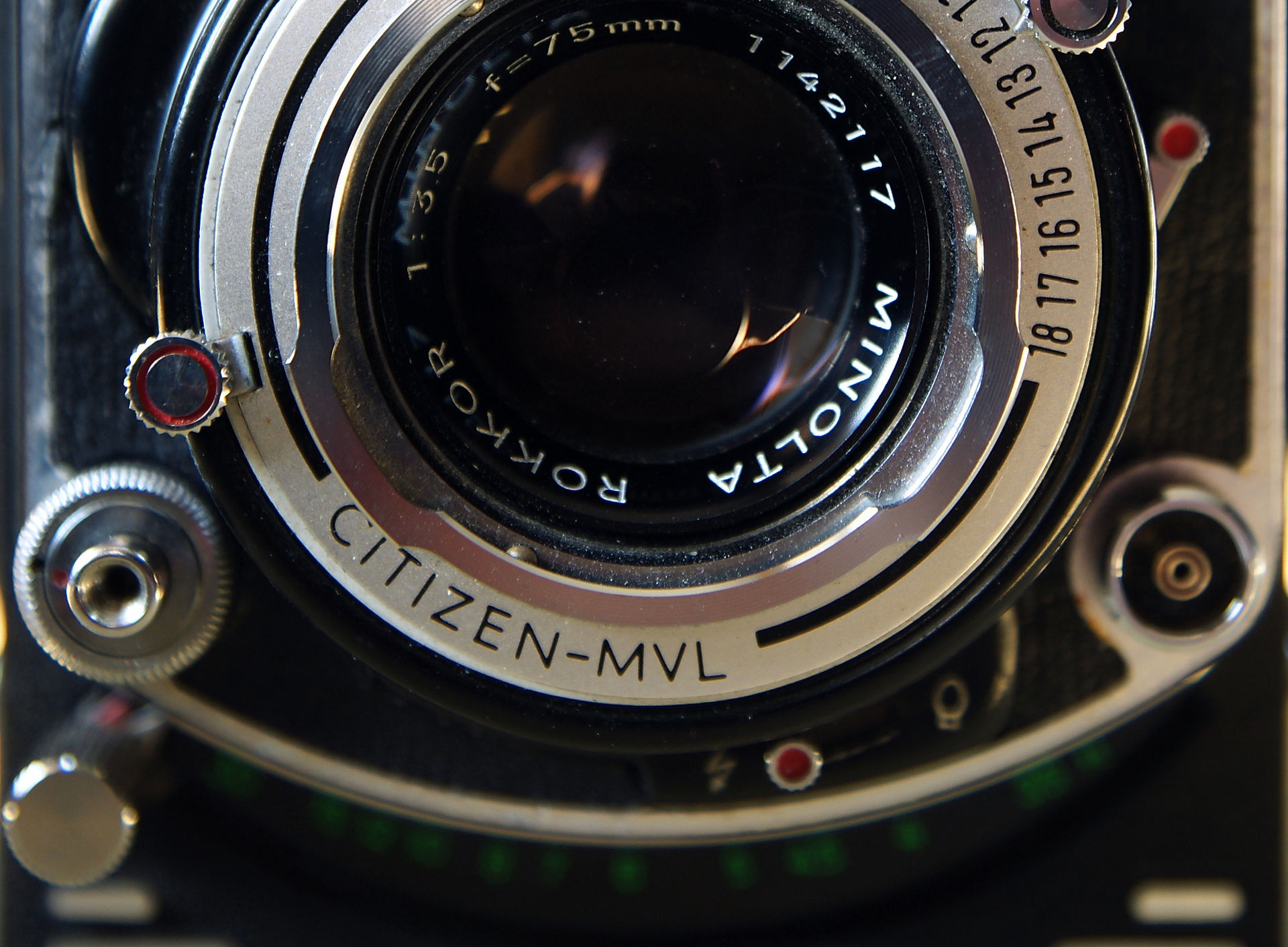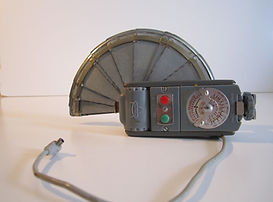
AUTOCORD : the Minolta's TLR
by Fred
Accessories for the Autocord
Several accessories can complete your Autocord.
The attachment to the bayonet lenses is the bay 1 system (28.5 mm).
The accessories cold shoe is a standard model.
1) Flash.
A) In 1956, Minolta released a folding fan type flash: the Junior B. C. (B. C. for Battery Capacitor).
13 segments parabolic dish, tilting head.
It includes a 200 MDF 22.5 W.V capacitor inserted into the compartment and needs a 22.5 Volts battery to operate.
It uses GE 5 type bulbs.



B) In 1962 appears a Deluxe model.
14 segments parabolic dish.
It uses a 300 MDF 15 W.V capacitor and a 15 Volts battery.
"OPEN" button to trigger with open shutter.
It accepts several models of bulbs :
-) Ba 15 (bayonet)
-) M (without bayonet)
-) AG (all glass)
Source : Etsy studio


C) In 1965 appears the Deluxe II model.
14 segments parabolic dish, shrinkable.
300 MDF 15 W.V capacitor and 15 V battery (type 504)
Disappearance of the "OPEN" button.
15 V battery and capacitor
M2 bulb AG-1b bulb
D) In 1969 appears the Deluxe III model.
Unfortunately, the flash shoe is not adapted to the Autocord's cold shoe.
If you absolutely want to use it, you will need a flash bracket (to be attached under the Autocord) and the connecting cable to trigger the flash with the Autocord.
13 segments parabolic dish.
300 MDF 15 W.V capacitor and 15 V battery (type 504)
E) Electronic flashes may also be suitable.
A flash bracket is essential (to be fixed under the Autocord) and a flash cable with a PC male plug to connect to the socket of your Autocord.

2) Lens hood.
To be placed on the taking lens to eliminate glares from the sun.
The leather case can also be used to carry filters or lenses,
it is marked " Minolta " and can cling to a strap .
One model, two versions, three leather cases :
-) before 1962 : marked "Minolta" ("Chiyoko" logo on case)
-) since 1962 : marked "minolta" ("Minolta" logo on case)
-) in 1965 and 1966 : new case (black with zipper) with "minolta" on it.
version < 1962 (source : ebay)


version 1962 - 1964 (source : ebay)
version 1965 - 1966 (source rockycameras.com)
3) Filters.
Various filters can be used : UV , soft, red, yellow, green ...
Do not limit yourself to the Minolta brand, several manufacturers produce accessories mounted in bay 1 ( Rollei,
Yashica, Spiratone, Aico, Spectron, MPP, Kenko, Waltz, Prinz, Camrex Hoya, Photax, Astron).
Do not limit yourself to the visible spectra : try the infrared (IR).
You can see some infrared photographs under the "Photos (french version)" button.
If you have questions, contact me.
4) Close-up lenses.
You can easily find close-up lenses with different strengths to shoot objects closely.
Minolta produced two sets : Nr 1 and Nr 2.
Nr 1 set is used for objects located between 40 and 65 cm from the taking lens.
Nr 2 set is used for objects located between 35 and 42 cm from the taking lens.
Each set includes three lenses :
-) lens A to be placed on the viewing lens;
-) lens A with a C to be placed on the taking lens;
-) lens B for parallax correction, to be placed on the A lens on the viewing lens. Red dot must be placed to upper side.
Tele and wide angle lenses are also available for a little closer what is far or to enlarge the point of view (Alpex, Sun, Spiratone, Kaligar, Rollei, Yashica or other brands). Allways two lenses sets.
Except the Rollei Magnar 4x (lone lens).


Source : Ebay
Standard version (Minolta)
De luxe version (Chiyoko)
5) Autopole.
Minolta has made a specific polarizer for his TLRs.
Both filters are coupled so that you can see what you will shoot.
Two versions : one marked "Chiyoda Kogaku - Japan" and the second "Minolta camera - Japan" (probably since 1962).
Also in de luxe version with a leather case.


6) Paradjusteur.
It is a block to be placed under the Autocord, possibly between the camera and a tripod.
It lets you capture exactly what you see in the view finder after moving up the camera with a height equal to the distance between the two lenses.
Very useful for close-ups without parallax correction lens.

Source : Ebay
Source : Ebay
Source : Ebay
7) Panorama head.
This device lets you get panoramic photographs.
It is equipped with a spirit level and a tripod fixing wheel.
The wheel is marked with 12 positions ( every 30 ° ) .
So with a 120 film , you can achieve a 360 ° view.

Source : Ebay
8) Timer.
Some Autocords do not have a timer : L, L-MX and derivatives.
Minolta manufactured an external timer in order to remedy this shortcoming.
It is to be screwed on the trigger.

Source : Ebay
9) Case.
All cases for Autocord are leather, are in two parts.
Several versions exist.
A) The brown holsters.
They are intended for all Autocord before 1965, they are equipped with a brown leather strap , it can be short or long . Some are designed to accommodate Autocord equipped with a measuring cell of light, they have an additional round block on the left hand side.
The oldest have a light brown hue, the most recent are darker.
I have not yet seen any brown case for Autocords that can use 220 type films, they should have an extra cutout in the right corner above the crank..


B) The black cases.
They are designed for the 1965 and 1966 Autocords. Several versions exist depending on the model.
For Autocord CDS, provide a case with an extra round block on the left hand side to accommodate the reading dial of the CDS cell (see below right) and a more advanced top to cover the CDS cell and the battery compartment.

Model for Autocord without CDS

Model for Autocord with CDS
(source : ebay)
The cases for II, III, CDS II and CDS III have an extra cutout in the right corner above the crank to let the owner access to the 24 views counter. See below on the right.

Model for Autocord CDS I
(source : ebay)

Model for Autocord CDS II and CDS III
(source : ebay)